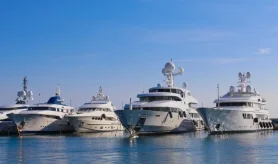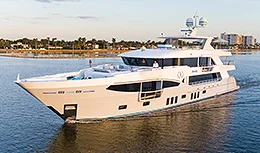- Alaskan Yachts
- Azimut Yachts
- Back Cove Yachts
- Beneteau Yachts
- Benetti Superyachts
- Bertram Yachts
- Boston Whaler
- Broward Yachts
- Buddy Davis Sportfish
- Burger Yachts
- Cabo Yachts
- Catamarans
- Carver Motoryachts
- Center Console
- Chris-Craft Yachts
- Cruisers Yachts
- DeFever Trawlers
- Dufour Sailboats
- Fairline Yachts
- Feadship Yachts
- Ferretti Yachts
- Filippetti Yachts
- Formula Yachts
- Fountaine Pajot Cats
- Grady-White
- Grand Banks Trawlers
- Hargrave Yachts
- Hatteras Yachts
- Hinckley Picnic Boats
- Horizon Yachts
- Hydra-Sports
- Intrepid Boats
- Jarrett Bay Sportfish
- Jeanneau Yachts
- Kadey-Krogen Trawlers
- Lazzara Yachts
- Lekker Boats
- Luhrs Sportfish
- Marlow Yachts
- Maritimo Yachts
- Marquis Yachts
- Mazu Yachts
- McKinna Motoryachts
- Meridian Yachts
- Midnight Express
- MJM Yachts
- Mochi Craft
- Neptunus Motoryachts
- Nordhavn Trawlers
- Nordic Tugs
- Numarine Yachts
- Ocean Alexander Yachts
- Ocean King
- Offshore Yachts
- Outer Reef
- Oyster Sailing Yachts
- Pacific Mariner Yachts
- Palmer Johnson Yachts

Dennis Kowalski: The Final Frontier
Somewhere inside Silicon Valley, billionaires are planning to live forever.
Perhaps they’ve signed up to a plan with Dennis Kowalski, president of the Michigan-based Cryonics Institute, a non-profit organization that vitrifies and super-cools dead people who hope, one day, to be thawed out and revived. It’s an idea, he concedes, that’s easy to mock.

“If you suggested 100 years ago that you could bring back the dead by pounding on their chest and giving them electric shocks, people would have said that was Frankenstein stuff. And that’s routine now,” notes Dennis Kowalski. “Cryonics is the same – we know that we can retain the flesh even if we can’t yet revive it, or don’t know if consciousness would survive. But this is a Pascal’s Wager – there’s the sense that reviving might be possible at some point in the future, so there’s nothing to lose.”
Kowalski is not the only one who sees potential in the idea of greatly extending human longevity, even if a study this year by the Roswell Park Comprehensive Cancer Center in Buffalo concludes that “physiological resilience” – our ability to bounce back from illness, injury or stress, which declines with age – gives us all an “absolute limit” of around 150 years. Those in the life extension game (businesses, scientists, intellectuals) might point to all manner of breakthroughs that suggest the potential for extended lifespans. And that’s beyond achieving that anyway through better nutrition, wealth and health education, which will see one in three American girls born today live to see 100.
There’s the idea, for instance, of replacement body parts. These may be technological. The bio-hacking community – self-experimenters including those who boldly, or, crazily, have fitted modifications to their body to allow, for instance, for the hearing of color or the sensing of electromagnetic radiation – has arguably set on the road to what cyborg expert Dr. Patrick Kramer calls “humans 2.0”.
Or they may be organic. “And if organ supply is no longer limited, why not get a new organ? Why wait until the one you have gives out?” asks CEO of BioLife4D, Steven Morris. BioLife4D has developed a system that tricks white blood cells into behaving like stem cells, uses those to create what Morris calls a bio-ink, and then uses that with an adapted 3D printer to print a functional human heart, albeit, for the time being, only a miniature version. “And if you’re replacing an organ, there’s the question of why not improve it too? Why not give a kid a heart with 30% more capacity, so he’s the star athlete at school? It creates all sorts of ethical issues.”

Similar tech has already successfully printed the first cornea, with the printing of skin also close. No wonder Yuval Noah Harari argues in his book Homo Deus that some combination of genetic manipulation, nano-tech or cloning (even some form of existence in cyberspace, as Russian billionaire Dmitry Itskov’s 2045 Initiative aims to achieve) points to extended human longevity becoming a reality. It’s all about seeing death less as an inevitable, unavoidable process, and more as a disease that needs to be tackled like any other.
That’s the thinking of maverick independent biologist Aubrey de Grey. His California-based organization SENS, or Strategies for Engineered Negligible Senescence, is working to combine technologies – some practicable, some still theoretical, some in clinical trials and some, skeptical detractors say, the stuff of sci-fi – to counter the cellular damage that accumulates until the point we die, “like a car initially gets harmless rust, and then keeps getting rust until the doors fall off,” as he puts it.
Don’t just replace the doors, de Grey argues, because it’s not possible to separate the process of living from the cellular damage caused. Instead, develop therapies that roll back that damage, so a 90-year-old is more like a 60-year0old, and so on down the age span. The initial intention, he says, is not to buy immortality, but a couple more decades. “You’ve bought time – but that’s time also for scientists to develop the next generation of the therapy, and eventually you get to postpone the pathology of old age faster than the pathology comes on.”
De Grey calls it “longevity escape velocity” and takes a punt on reckoning that there’s a 50% chance of this therapy becoming a real thing, at least for those who could afford it, within the next couple of decades. And this immortality through periodic renewal is not just for those who can afford it. It would also, of course, be for those who want it, because underpinning this fledgling science of life extension is the assumption, somewhat taken for granted, that it’s what people want.
“How would our relationships fare with each other and the many generations that would be thrown together? What would you do with all the time?”
Yet that’s not clear, as surveys often show. Most people, it seems, can see the appeal of a couple of centuries perhaps. But immortality? A New Scientist study has suggested only one in five people would want it. After all, what impact would all these extra perma-people have on employment, government coffers or pollution? How would our relationships fare with each other and the many generations that would be thrown together? What would you do with all the time? What value would living actually have? What if you lived on but your loved ones checked out?
Good or bad, Dennis Kowalski is keen to find out. He’s spent $20,000 for his body to be cryogenically stored. “It’s not so much that I’m afraid of death,” says the one-time firefighter and serviceman, “more that I’m optimistic and a bit of a futurist – and I want to be around to see what comes. “
Request a Copy [FRANK Issue 2]
From intelligent debate to cutting-edge science, and risky sports to surreal charter experiences, FRANK does not shy away from the awkward, controversial, or questionable details. Brazen at times, amusing in spirit, and always transparent in discussion, the focus is on discovering new angles and enjoying every minute. And, of course, always being ‘frank’ about the conclusions.

Request A Copy






